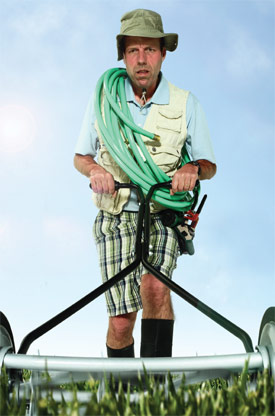The Grass is Always Greener
How far are you willing to go to keep your grass green? As dandelions spread, we take a closer look at local perceptions – from the organic to the pure aesthetic – as to what really makes the perfect lawn.
By Elizabeth Wilcox
It should come as no surprise that if you want to enter a hornet’s nest in suburbia, the best place to start is on your lawn. My own is a case in point.. When my family moved into our home several years ago, we inherited a large front lawn. Given the size and location of our two-hundred-plus-year-old Ash behind our house, the front quickly became the children’s play space. Two weeks into spring, the grass was littered with chipped Adirondack chairs, sodden Styrofoam rockets, florescent orange ping-pong balls, even a small rubber frog hidden beneath the hosta in the border beds. When dandelions began to bloom, our trouble began.
Faced with the chore of unpacking boxes, we did nothing that first spring, except to smile lovingly from our front porch as our cherished children blew wishes on seeding dandelion heads. Needless to say, the next spring the lawn was strewn with the yellow-flowered weed. “Can’t understand how these have multiplied on your lawn,” our neighbors good naturedly opined while throwing a quick glance to our yard. Not wanting to be run out of town, we decided to take action. What we could not decide was which action to take.
From afar, it may seem simple to care for a lawn, but in truth lawn care in Wellesley and Weston is anything but straightforward. Perceptions of the ideal lawn and how to achieve it can vary significantly from one neighbor to the next. And while some lawn- care practices can be written off as no-one’s-business-but-my-own (such as how often the grass is cut) other practices ignite the passions of those who may never set eyes on your lot.
Perhaps the most incendiary topic is the environmental impact of pesticides. Pesticides are, by design, poisonous to living organisms and many now campaign against their use for the harm they may cause to children and animals. For some, synthetic fertilizer, too, is not ideal as excess nutrients can contaminate drinking water and cause algae growth in ponds and bays. But some also warn against organic fertilizers as heavy rain immediately after application can lead to excess nutrients in water run-off from the lawn. Overuse of water, particularly during shortages, can raise brows as well.
Ask neighbors and friends about lawn care practices, and you’ll soon find out how complex these issues can be. Not all conservationists, it turns out, are opposed to minimal use of synthetic fertilizer. Not all lawn reformists own what some would label a lawn. Not even all marriages sit on solid ground when it comes to what’s desirable in a patch of grass. Take the father of one Wellesley resident: After his divorce, he paved the entire front lawn to spite his wife and relieve himself of ever having to mow a single blade of grass ever again.
Brian Donahue, co-founder of Weston non-profit community farm Land’s Sake and Associate Professor of Environmental Studies at Brandeis University (who rents his Weston home but maintains its grounds), admits that lawns can be a polarizing issue. Fortunately, his views on lawn care are in line with the owner of his home. Donahue likes the buttercups, dandelions, and patches of forget-me-nots that spring up. He also points out that in this area of the country, there’s nothing natural about a lawn. Even having one is working against nature to some extent.
So how do you create a perfect lawn?
Lawn- care experts suggest you begin with a clear understanding of what you want out of your lawn. Landscape architect and Wellesley resident Dan Gordon suggests that you take time to consider your expectations and think about how your lawn will be used.
Weston resident Trish Scazzofava has done some thinking on that. Her children and two Bernese mountain dogs use her yard frequently so she uses neither fertilizer nor pesticide out of concern for their health and the environment at large. In exchange, she’s willing to put up with few broad-leafed weeds. “My lawn just needs to be green when you’re driving by at 25 mph,” she jokes.
Pragmatism reigns for nearby neighbors Russell and Nancy Iuliano. Because their forty-eight-inch lawn mower is difficult to turn, Nancy redesigned their lawn to be circular rather than square. Dogs and neighboring children also mean they keep fertilizer and pesticide to a minimum.
Anti-pesticide advocate and Wellesley resident Sarah Little is more passionate about her lawn. Alarmed on her arrival into town at the use of pesticide and its potential implications, she does not use it. She fertilizes primarily with her own compost, and does not water her lawn, believing its ecosystem is better adapted to its natural environment. Mixed in her lawn are clover, hawkweed, asters, and a variety of grasses.
“Over the course of the summer, what’s growing changes. That’s why it’s so robust,” she claims. “We have a lot of diversity. It’s always green, wonderful to walk on, and we feed the dandelion heads to the rabbits.”
Regardless of whether you have the time or the interest to create such biodiversity, experts agree that some basic principles can help most any landowner create a healthier lawn. They include: not over fertilizing, mowing higher, and watering only as needed. Or as the Massachusetts Department of Environmental Protection advises, “The key word is less.”
That first year we lived in Weston, our family ignored many of these principles. Thanks to my English heritage, I strove to create a lawn like a Wimbledon tennis court, destroying the longer grass canopy which can help contain dandelion growth. By summer, we were paying our daughter one cent for every dandelion she pulled when we should have tackled them as they emerged in the spring. Our soil was poor. The end result was a field of crabgrass, more dandelions, and burnt grass. Added to this was the resulting consternation of our neighbors. But should we implement what we know now, perhaps they won’t run us out of town this summer, at least not because our dandelions have seeded on their lawn.
Tips for A Healthy Lawn
1. Pay Attention to the Soil
Maintain adequate depth to your soil, a minimum of six inches. If water pools on high traffic areas, consider aerating the soil. You can rent powered aerators which facilitate the flow of water, air, and nutrients into the soil. Leaving clippings on grass after mowing is also good for your soil, adding nitrogen. Spreading lime can benefit acidic soil which is common to this region. Compost can help if your lawn needs nutrients. Compost should be top-dressed or spread thinly in early spring or fall. If you want to know the composition of your soil, you can go to www.umass.edu/plsoils/soiltest to arrange to have your soil analyzed. If you decide your soil is in need of fertilizer, try not to apply itbefore a heavy rain. Read the labels and follow instructions carefully.
2. Water Only As Needed
Don’t over water. One inch a week is usually sufficient. Water deeply and less frequently to encourage root growth. Morning is best. According to the 2005 Greenscapes Guideof the North and South Rivers Watershed Association (NSRWA), you can test your grass by checking if it stands up straight after being walked on. If you can clearly see your footprints in the lawn, the grass is thirsty. Alternatively, you can use a rain gauge to monitor how much rain has fallen. For those who have an underground sprinkler system, make sure it includes a moisture sensor can shut off the sprinklers when it’s raining.
3. Seed Appropriately
Use the right grass seed, bearing in mind factors such as sun, shade, and drainage. Seed in fall and spring, using compost on bare spots before re-seeding. Also consider fescue grasses (these include chewing, hard, creeping, and sheep fescue) instead of Kentucky Bluegrass varieties which demand more feeding. According to the Greenscapes Guide, fescue lawns are more insect-resistant, require less water, less fertilizer, and less mowing than many other grass types. They also can tolerate the slightly acidic soils common in this area.
4. Mow high
Not cutting the grass below three inches is recommended, though never cut more than one-third the grass blade’s height. Keep lawnmower blades sharp for a clean cut to avoid making your lawn more susceptible to drought, weeds, and disease. The blade should be sharp enough to crease the skin on your thumb
Primary Sources: Massachusetts Department of Environmental Protection and 2005 Greenscapes Reference Guide, NSRWA (available at www.nsrwa.org/greenscapes/guidebook)
For more information on the Wellesley Pesticide Awareness Program go to http://home.comcast.net/~little.sarah/
To find out more about environmentally sound lawn care, go to www.buzzardsbay.org/lawncare.htm
© 2006 Elm Bank Media



recent comments